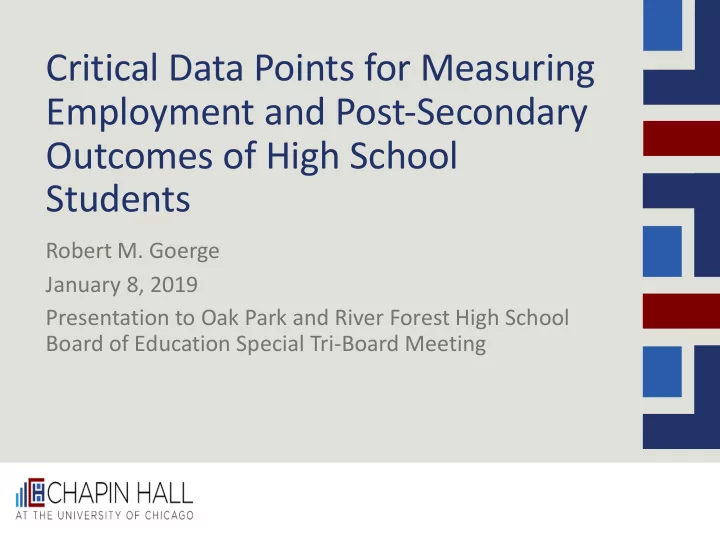

Critical Data Points for Measuring Employment and Post-Secondary Outcomes of High School Students Robert M. Goerge January 8, 2019 Presentation to Oak Park and River Forest High School Board of Education Special Tri-Board Meeting
Goals of this presentation • “key data points, which would be used (over time) by the community to measure and monitor students' readiness for college and careers in a 21st century global society.” • What is possible • What some of the challenges are
Chapin Hall at the University of Chicago • Organization that was brought to the University in order to have an impact on the well-being of children through better research and analysis • Over the past 30 years, we have built relationships with policymakers in order to have that impact through conducting research that meets their needs • Known for our work with human services administrative data, we employ a full range of methods and address many issues of children, families and their neighborhoods
CWICstats project • Chapin Hall was funded by Bill and Melinda Gates Foundation from 2007-2010 to develop a regular program “benchmarking report” using meaningful performance measures that policymakers and managers within the education and workforce system can use, including background measures on program participants, and outcome measures
Data • The Chicago Public Schools (CPS) provides records on attainment of the high school diploma . • The National Student Clearinghouse (NSC) provides enrollment history and degree attainment data for current and former students from more than 2,800 colleges. Approximately 91 percent of all accredited U.S. colleges and universities report individual enrollment information to NSC. • Illinois Department of Employment Security Unemployment Insurance Wages
Sample • Initial sample First-time 9 th grade students in Chicago Public Schools in Fall 2000 • and fall 2001 cohorts: 57,235 • Given data limitations, sample was limited to: • Students with valid SSNs (for data linking): 52,594 • And confirmed to be living in Illinois during 2009-10: 47,006 • Overview of study sample: 47,006 • Students who graduated from high school: 26,696 • In wage data at all – 33,328 (71%)
Outcomes for Chicago HS students Graduated? Post-Secondary? Employed? 73% Yes 70% Yes $4,832 57% Fall 65% No 30% 2001/2002 $4,721 9th 55% Yes 28% graders No $3,887 47,006 37% 45% No 72% $3,826 56% Left/transferred out of CPS: 6% of cohorts $ 4,392 2,973
CPS 9 th grade cohort graduates: College/Post-Secondary Enrollment & Persistence Enrolled and Persisted to 2nd Year Enrolled without Persisting 100% 15% 80% 19% 60% 29% 28% 34% 25% 27% 40% 75% 59% 46% 42% 20% 38% 37% 37% 0% Overall Black Hispanic White Asian Male Female Overall 70% of the high school graduates enrolled in post-secondary education, with 42% persisting (enrolled in college for 8 months in first year and returning for second consecutive year)
CPS 9 th grade cohort high school dropouts: College/Post-Secondary Enrollment & Persistence Enrolled and Persisted to 2nd Year Enrolled without Persisting 100% 80% 60% 40% 19% 8% 20% 22% 20% 22% 16% 19% 27% 20% 13% 10% 8% 6% 6% 0% Overall Black Hispanic White Asian Male Female Overall 28% of the high school dropouts enrolled in post-secondary education, with only 8% persisting (enrolled in college for 8 months in first year and returning for second consecutive year)
Mean Earnings - Graduates by PS Enrollment and Dropouts - All $6,500 $6,000 $5,500 $5,000 $4,500 $4,000 $3,500 $3,000 2010 Q1 2010 Q2 2010 Q3 2010 Q4 Graduates, Enrolled and persisted to 2nd year Graduates, Enrolled - Did not persist Graduates, no Post-Secondary Dropouts
Females Were More Likely to Work in Health Care and Social Assistance Sectors Than Males 100% All other 90% 21% 23% 25% Manufacturing 80% 2% 4% 6% Finance and Insurance 7% 70% 5% 3% 3% 5% 9% Transportation and 8% 60% 6% Warehousing 3% Social Assistance 10% 5% 15% 50% 11% Health Care 11% 40% 11% Accommodation and Food 30% 18% 14% Services 11% Administrative and Support 20% Services Retail Trade 22% 21% 10% 20% 0% All Employed Males Females
Females Were More Likely to Work in Health Care and Social Assistance Sectors Than Males 100% All other 90% 21% 23% 25% Manufacturing 80% 2% 4% 6% Finance and Insurance 7% 70% 5% 3% 3% 5% 9% Transportation and 8% 60% 6% Warehousing 3% Social Assistance 10% 5% 15% 50% 11% Health Care 11% 40% 11% Accommodation and Food 30% 18% 14% Services 11% Administrative and Support 20% Services Retail Trade 22% 21% 10% 20% 0% All Employed Males Females
Challenges • Post-secondary data • National Student Clearinghouse data • Employment data • Requires Social Security Number, which school districts are not required to maintain
Recommend
More recommend